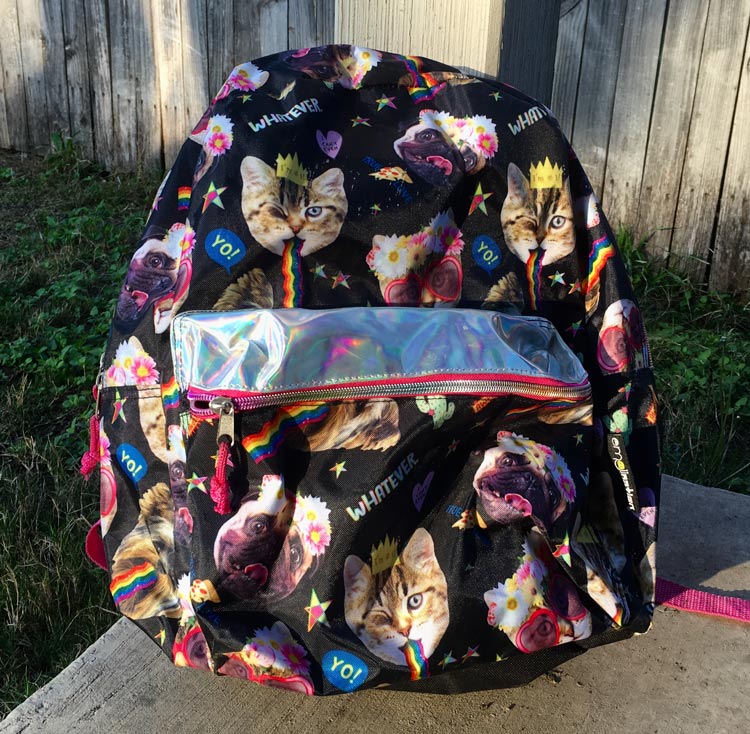Most ultramarathons only require you move at an 18 to 20 min/mile pace to finish. If you can hike briskly, you should get a belt buckle. But hundreds of runners miss time cutoffs at ultras every year. Twin Lakes Inbound at the Leadville 100 is a particularly grim cutoff scene. It’s heart breaking for everybody involved.
If cutoffs are your nemesis, try the following aid station tactics. They’ll easily give you a 30-minute cushion. In a 100 miler, you’ll likely end up with an hour’s worth of safety net. And if you just want to PR or nose out a rival without running any faster, try these strategies too.
Use a drop bag that’s easy to find.
No matter how well aid stations organize the drop bag area, it will take volunteers longer to find your bag if it looks like everybody else’s bag. Use a bag that stands out to speed the retrieval up. Tiffany Brown Anderson uses a book bag covered with large kittens vomiting rainbows. Volunteers have no trouble finding it.
Organize your drop bag.
You want to be able to reach into your bag and grab whatever you need quickly. Try using large Ziplock bags to separate items. Put clothes in one bag, foot care items in another, your headlamp and batteries in another, food in another etc. Then label each bag with large letters. This will make it easier for anyone who is helping you to find what you need quickly too.
Make an index card to remind yourself what you want at each aid station.
Carry the card with you, put it in your drop bag or give it to your crew. Don’t waste time trying to remember your plan or having long conversations with your crew about what you might need.
Open your water bottles or hydration pack before you get to the aid station.
Long-time ultrarunner and aid station volunteer Chris Russell was surprised by how many runners waited until they got to the aid station to take off their hydration packs at Rocky 50 this year. “It’s much more efficient to slow down 25 to 50 yards before the aid station and pull off your pack, take out the bladder and open it while you’re walking.” Veteran mountain runner Brian Ricketts agrees, “If you have bottles, go ahead and take them out and have them ready. Dump powder in them before you get there.”
Keep walking.
Let the volunteers fill your water bottles or hydration pack if they offer or do it yourself, then fill a small Ziplock bag with some food, and eat it as you walk away from the aid station. Don’t stand around and eat, no matter how delightful the aid station volunteers are. Relentless forward progress!
Carry a small blister kit.
Carry a few pieces of precut tape and some tincture of Benzoin with you to slap on any hot spots that develop before you get to an aid station. Blister care and waiting for blister care sucks up huge amounts of time, so prevent blisters if you can. Also, take the time to teach your crew members how they can help with your feet and have them practice taping. Trust me on this one.
Make a full resupply bag for each loop.
If you’re running a multi-loop course, make up gallon-sized Ziplock bags for each loop and label them accordingly. When you come into the start/finish area, take everything out of your pack and restock it with the resupply. If you have a second pack, pre-load it and use it for the second loop, then have your crew refill the first pack with the resupply for loop three etc.
Give your crew a time goal.
This is especially useful if your crew is inexperienced and doesn’t understand how a seemingly quick 10-minute stop can easily add an extra hour or two to your finishing time if there are six or more aid stations. Before the race, tell your crew how long you plan to stay at an aid station and assign someone to be a timer.
Thank the volunteers with gusto.
The friendlier you are to the aid station volunteers, the more they will cheer for you. The more they cheer, the faster you’ll run or hike. Try it.
Volunteer.
The best way to learn to be efficient (and inefficient) is to volunteer and see how other runners do it.
Remember every minute you save at an aid station, is a minute off your finishing time.




2 comments
Good article! I just wanted to point out, though, that while it’s true that an overall average pace just slightly under 18 minute miles will get you a buckle in Leadville, you have to go considerably faster than that for the first 60 miles or you’ll miss an earlier cutoff. It’s only after Twin Lakes inbound that the cutoff times relax a bit. I know this from unfortunate personal experience…
I love this list, Liza. I’ve had the joy of self-discovery for most of these (like my Teenage Mutant Ninja Turtles drop bag) but think it’s wonderful to share and accelerate the learning curve.
On blisters, I’ve run through 50 miles of very hilly, slushy, watery, mud and my feet did just fine — I haven’t had a blister in 6+ years and dozens of races. If you’re getting blisters, I think either you’re in the wrong shoes or doing something wrong. I wear a pair of liners plus a pair of double layer socks (3 layers in all) and lather up with a ton of coco-butter, no tape needed. May seem excessive, but it works. Blisters are avoidable. And it means I don’t have to decide whether to spend time changing shoes or socks at an aid station – I don’t need the option.
Comments are closed.